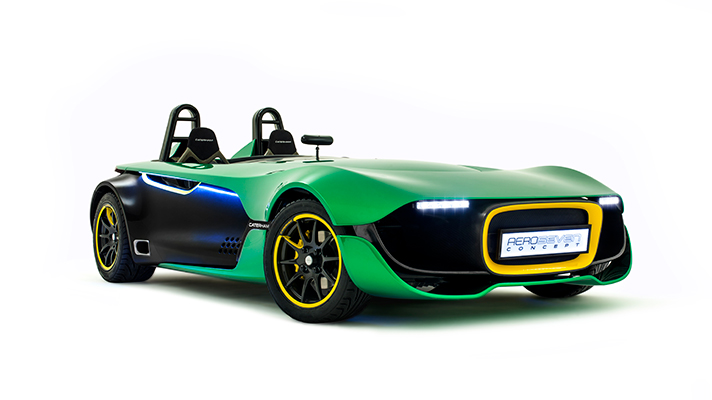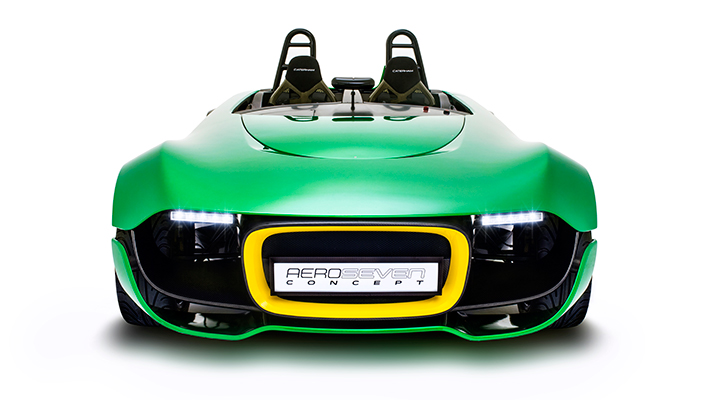
Caterham and the AeroSeven Concept
Caterham Cars is calling it the AeroSeven Concept, a first glimpse of an all-new roadcar due to arrive next year, and under the slightly over-liberal use of green paint, hints of the styling direction for the sportscar being developed with Renault, due for release in 2016. This is big news. Because although the basic philosophy remains comfortingly familiar - light, involving, deeply obsessed with power-to-weight - the AeroSeven features lots of things you don't usually associate with a Caterham. Like 21st century technology.
The AeroSeven may be based on the current CSR platform, but employs the black art of aerodynamics to produce actual downforce - previously only encountered on a traditional Seven if someone sat on one. Suspension is fully-independent at the back, and F1-ish inboard pushrods at the front, with bespoke springs and dampers to cope with the fact the body isn't just a wrapper to keep the rain off the oily bits anymore.
There's traction control, featuring a launch control function, and actual ABS braking. More than that, the steering wheel will operate much like an F1 helm, adjusting throttle maps and the ‘Pit Lane speed limiter' - always a bonus at drive-through restaurants. There'll be a new ‘graphical display unit' or GDU, developed by Caterham Technology and Innovation, to throw up data on gears, revs, speed, fluid levels and temperatures and all the associated numbers that you might find useful. One gets the impression that the AeroSeven might be a bit biased to the track-day enthusiast though: the default throttle map is ‘Race' - you have to select ‘Road' specifically from the wheel-mounted button.
The hardware under the newly-swoopy bonnet is slightly less news-worthy, the proven 237bhp, 2.0-litre four-pot Ford Duratec mated to a six-speed manual driving the - you guessed it - rear wheels. Fast? The numbers add up to a car that should hit 62mph in around four, with 150mph capability. But as ever with Caterham, don't rule out options for transplants, not least because Caterham recently signed a deal with Suzuki to use its three-cylinder turbo in future cars. Which would make the AeroSeven, or its spawn, even lighter.
There is, however, a bigger story behind the AeroSeven. Because since 27th April 2011, when Team Lotus owner Tony Fernandes bought the company, Caterham Cars has been quietly gearing up for change. It's had to, to be honest. It's been forty years since Caterham Car's founder Graham Nearn first snapped up the rights to Colin Chapman's Lotus 7. Forty years in which the Caterham Seven has become something of an icon for those who prefer their sportscars light and direct, simple and unfettered. And forty years in which the Seven has remained largely unchanged, a tubular spaceframe with an aluminium body, unencumbered by the fat and flab of modern legislation.
There have been mutterings of modernity: the mid ‘90s saw the Caterham 21, a full bodied, more comfortable Caterham, but a slow sales start and the contemporary Lotus Elise saw to it that only 48 examples ever made it to the road. The Seven itself has spawned variant after variant, from wide-bodied SVs to fantastically-scary R500s, cars that reminded us how isolating modern sportscars can be. Vivid, raw, uncompromising cars. But variations on a narrow theme nonetheless, and cars that harked back to another time, stuck in a bit of a timewarp.
Flick back to 2013, and Caterham has an F1 team, a ‘Technology and Innovation' arm and a composites facility, as well as the factory itself in Dartford, Kent. Deals have been done with Suzuki for that 660cc turbo engine to produce the cheapest (sub £17k) Seven ever, and Renault and Caterham have joined forces to create a joint venture, the ‘Societe des Automobiles Alpine Caterham', based at Renault's Alpine plant in Dieppe, to revitalize the Alpine brand.
The big boys have resolutely got involved with what was a fairly small-scale UK company. Renault's chief executive Carlos Ghosn said partnering with Caterham would help "realise our long-held ambition of creating a sports vehicle with the Alpine DNA" and with his title of Caterham Group chairman, Tony Fernandes said the deal should help transform Caterham from a "well respected niche brand into a serious player on the motoring map".
And you know what? It might just do that. New cars, new thinking, big plans. Caterham, it turns out, is just as much a born survivor as the cars it produces. Fingers crossed.
Top Gear
Newsletter
Thank you for subscribing to our newsletter. Look out for your regular round-up of news, reviews and offers in your inbox.
Get all the latest news, reviews and exclusives, direct to your inbox.
Trending this week
- Car Review
BMW iX3









